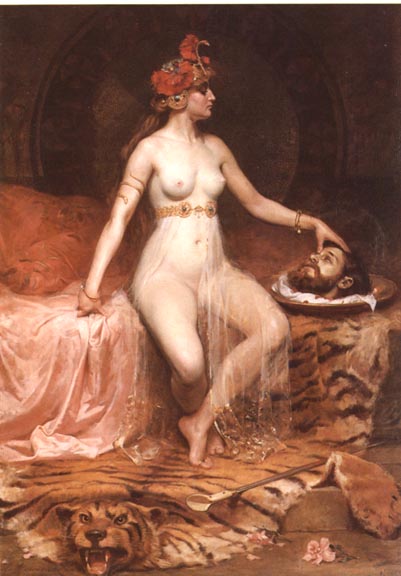In 1891, Oscar Wilde wrote a dramatic version of Salome in response to the long passage in Huysmans' Against Nature, in which Des Esseintes ponders two paintings of the subject by Moreau. Wilde crafts an entire play out of the few lines offered in the Gospel of Matthew, in which he depicts Salome as a dangerous femme fatale: scornful, dangerous, and wiling to use her sex to her ends. Aubrey Beardsley's illustrations add yet another dimension to Wilde's play, filled with caricatures of Wilde, frontally nude figures, and details that Wilde does not even mention. This relation between text and image inverts the method of the Pre-Raphaelites and the works of Hogarth that inspired them. Rather than an image replete with meaning that would be understood by one steeped in religious teachings, Beardsley grafts set of images onto the text even more decadent and offensive than Wilde's work.




Left: Gustave Moreau's The Apparition. Left middle: Gustave Moreau's Salome dancing before Herod Right middle: Pierre Bonnaud's Salome. Right: Aubrey Beardsley's The Climax. [Click on thumbnails for larger images].
Perhaps most striking about Beardsley's work is the stark black and white ink style he uses, especially when taken in the context of the lushly colorful previous depictions of Salome, such as those by Bonnaud and Moreau. In The Peacock Skirt, we see the figure (presumably Salome) almost completely abstracted: the dress and its pattern is certainly more important that her actual figure. In the illustration of The Climax, the blood dripping from John the Baptist's head becomes its own sinewy line, and melts into the pool of water out of which a lotus grows. Most of the drawings lack any sense of setting or depth. Beardsley is clearly more interested in experimenting in line and pattern through ink than with presenting 'accurate' illustrations. The Black Cape is completely unrelated to the play - he merely wanted a space to satirize contemporary fashion.
Questions
1. How does Beardsley produce shock value in his images, and to what extent does he include certain components purely to that end?
2. What function do the many caricatures of Oscar Wilde serve? Are they intended to satirize the work in general, or are they merely friendly nods?
3. Would Wilde have envisioned the costumes and sets as Beardsley paints them — as Art Nouveau and Modern — or in period piece? How does the meaning of the story as a whole change if pictured in Beardsley's Art Nouveau style?
4. The figure of Salome appears almost demonic in Beardsley's drawings. How does this contrast with previous depictions, and what does this say about his attitude towards Salome as a figure?
Last modified 22 April 2008